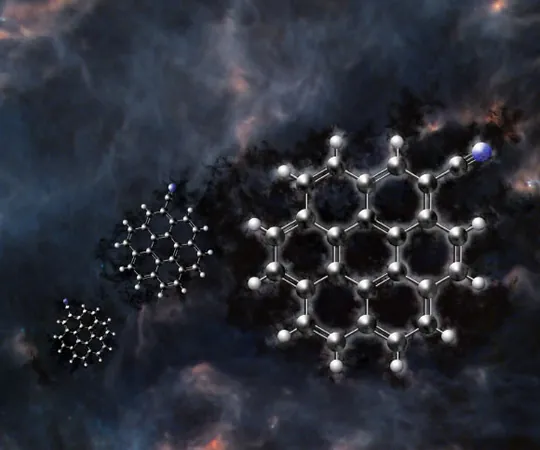
Astronomers Make Groundbreaking Discovery: Largest Organic Molecule Found in Space!
2025-06-16
Author: Wei
Cyanocoronene Unveiled in the Heart of the Cosmos
In an exciting breakthrough, astronomers have detected cyanocoronene (C24H11CN), the largest polycyclic aromatic hydrocarbon (PAH) ever identified in space, nestled within the starless cloud core TMC-1, which resides in the captivating Taurus Molecular Cloud.
Unlocking Cosmic Chemistry
PAHs, a class of organic molecules believed to be abundant throughout the universe, play a crucial role in the cosmic chemistry necessary for star and planet formation. Until this discovery, only smaller PAHs had been observed, making this find a monumental leap forward in our understanding of these complex molecules.
Dr. Gabi Wenzel from MIT and the Harvard & Smithsonian Center for Astrophysics states, "Each new detection brings us closer to understanding the origins of complex organic chemistry in the Universe—and perhaps, the origins of the building blocks of life themselves."
The Hunt for Cyanocoronene
The team employed advanced spectroscopic techniques to first synthesize cyanocoronene in a lab, establishing its unique molecular signature. With this fingerprint in hand, they scoured data from the NSF’s Green Bank Telescope as part of the GOTHAM project, successfully identifying several distinct spectral lines of cyanocoronene. This remarkable detection reached a statistical significance of 17.3 sigma—a significant achievement in astronomical research.
A Surprising Abundance
What’s even more astonishing is that the amount of cyanocoronene located is comparable to that of smaller PAHs previously found, defying expectations that larger molecules should be rarer in the cosmos. This finding hints that even more complex aromatic compounds could be routinely present throughout space.
Building Blocks for New Worlds?
Researchers suggest that the existence of stable, large PAHs like cyanocoronene indicates they may act as major reservoirs of carbon, potentially providing the foundational materials required for new planetary systems. The exquisite quantum chemical analysis reveals that cyanocoronene can form in the frigid conditions of space via reactions involving coronene and the CN radical, demonstrating that intricate organic chemistry can precede the birth of stars!
Connecting the Cosmic Dots
This astounding discovery not only enriches our understanding of cosmic chemistry but also reinforces the PAH hypothesis, linking interstellar clouds' chemistry to the organic materials found in meteorites and asteroids. It raises the tantalizing possibility that the organic molecules present in our own Solar System could have originated in similar environments long before our Sun's formation.
A New Cosmic Chapter
The findings were unveiled during the recent AAS246 meeting, marking a pivotal moment in astronomical research. As scientists continue to delve into the mysteries of the universe, this discovery illuminates the potential pathways through which life-essential materials may traverse the cosmos.





 Brasil (PT)
Brasil (PT)
 Canada (EN)
Canada (EN)
 Chile (ES)
Chile (ES)
 Česko (CS)
Česko (CS)
 대한민국 (KO)
대한민국 (KO)
 España (ES)
España (ES)
 France (FR)
France (FR)
 Hong Kong (EN)
Hong Kong (EN)
 Italia (IT)
Italia (IT)
 日本 (JA)
日本 (JA)
 Magyarország (HU)
Magyarország (HU)
 Norge (NO)
Norge (NO)
 Polska (PL)
Polska (PL)
 Schweiz (DE)
Schweiz (DE)
 Singapore (EN)
Singapore (EN)
 Sverige (SV)
Sverige (SV)
 Suomi (FI)
Suomi (FI)
 Türkiye (TR)
Türkiye (TR)
 الإمارات العربية المتحدة (AR)
الإمارات العربية المتحدة (AR)